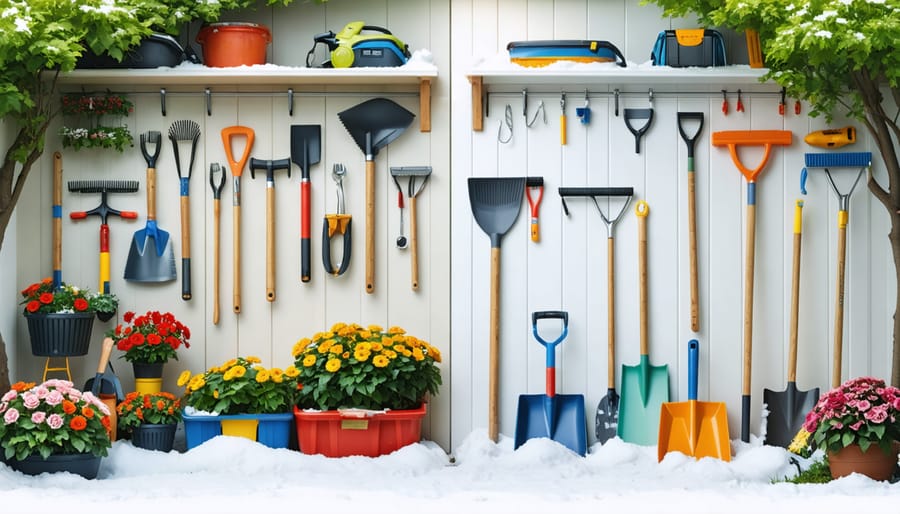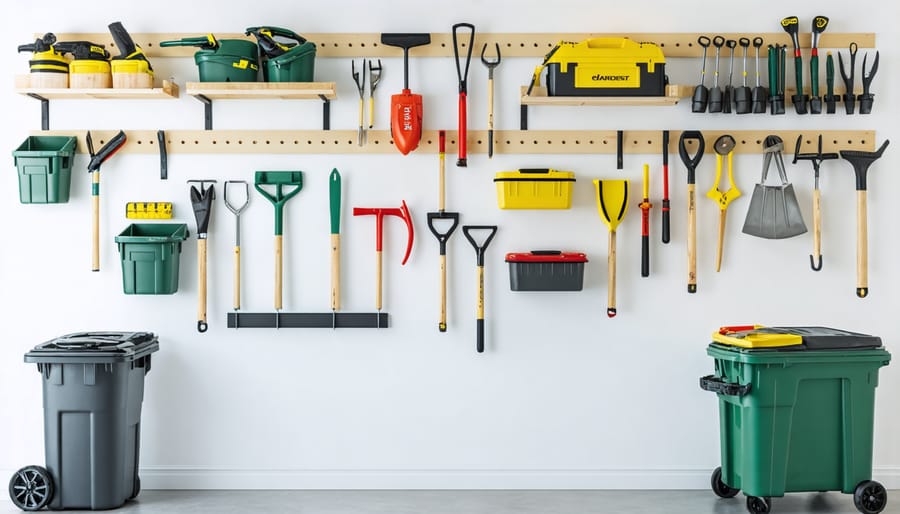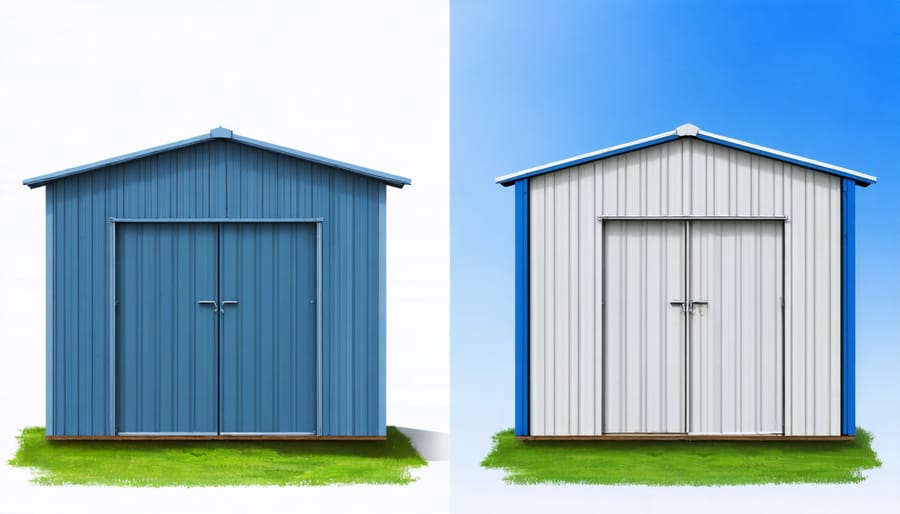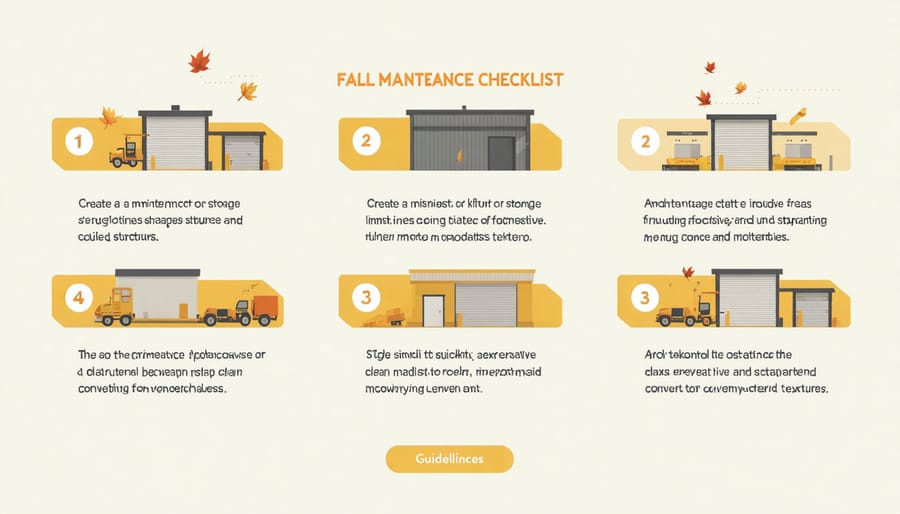Smart Storage Solutions That Adapt to Every Season

Transform your outdoor storage space through proven seasonal storage adaptations that protect valuable items year-round. Install adjustable ventilation systems with weatherproof seals to regulate internal temperature and humidity levels automatically. Create modular shelving zones that flex with changing storage needs, incorporating moisture-resistant materials for ground-level storage and breathable covers for seasonal equipment. Implement smart drainage solutions around storage structures using graded gravel beds and strategic gutter placement to prevent water damage during extreme weather.
Nature’s most resilient ecosystems thrive through constant adaptation, and your storage space should do the same. Strategic organization, weather-resistant materials, and responsive design elements work together to shield your belongings from heat, cold, moisture, and pests. By incorporating these ecosystem-inspired solutions, your storage space becomes a dynamic environment that responds effectively to seasonal challenges while maintaining optimal conditions for stored items.
Practical adaptation strategies extend storage life, reduce maintenance costs, and ensure reliable protection through every season. Think of your storage space as a living system that requires balanced airflow, moisture control, and temperature regulation to function at its best.
Spring Storage Solutions: Managing the Growth Season
Garden Tool Organization Systems
A well-organized garden tool storage system is essential for maintaining your equipment and making your gardening tasks more efficient. Start by categorizing your tools based on frequency of use, with frequently used items like hand trowels and pruning shears stored at eye level for easy access. Install a pegboard wall system with adjustable hooks to keep long-handled tools like rakes and shovels upright and off the ground, preventing rust and damage to handles.
Create designated zones within your storage area: one for hand tools, another for power equipment, and a separate space for seasonal items. Use clear, stackable bins to store smaller items like gloves, twine, and plant markers. Label everything clearly to maintain organization throughout the busy growing season.
Consider a mobile tool cart or caddy for frequently used items, making it easy to transport tools around your garden. Install a magnetic strip for metal tools and add a small workbench area for basic maintenance tasks. Keep chemicals and fertilizers on high shelves away from moisture and direct sunlight.
To protect your tools during peak usage, implement a cleaning station with brushes and old towels. After each use, clean tools thoroughly and apply a light coat of oil to metal parts to prevent rust. This simple maintenance routine will extend the life of your gardening equipment and keep your storage system functioning smoothly throughout the growing season.

Managing Spring Moisture and Ventilation
Spring moisture can wreak havoc on stored items if not properly managed. As temperatures rise and rain becomes more frequent, it’s crucial to implement effective moisture control strategies. Start by checking your storage structure’s foundation for proper drainage, ensuring water flows away from the building rather than pooling around it.
Install moisture-absorbing products like dehumidifiers or desiccant bags in strategic locations throughout your storage space. These simple solutions can make a significant difference in maintaining optimal humidity levels. Consider placing stored items on pallets or shelving units to elevate them off the ground, providing an extra layer of protection against potential water seepage.
Proper ventilation is equally important during spring months. Install vents near the roof and foundation to create natural airflow that helps prevent condensation buildup. On dry, sunny days, open doors and windows to allow fresh air circulation. This practice helps eliminate stale air and reduces moisture accumulation that can lead to mold and mildew.
Weather stripping around doors and windows should be inspected and replaced if necessary to prevent water infiltration during spring storms. Additionally, consider adding gutters and downspouts to direct rainwater away from your storage area effectively. Regular maintenance of these systems ensures they continue functioning properly throughout the season.
Remember to check stored items periodically for any signs of moisture damage and adjust your ventilation strategy as needed based on local weather conditions.

Summer Protection: Heat and Weather Management
Temperature Control Solutions
Maintaining the right temperature in your storage structure is crucial for protecting your belongings throughout the year. Start by installing a reliable system to monitor storage temperatures so you can make informed decisions about climate control.
Insulation is your first line of defense against temperature fluctuations. Consider installing reflective foil insulation in the walls and roof to reflect heat in summer and retain warmth in winter. Weather stripping around doors and windows helps maintain consistent temperatures while preventing moisture infiltration.
Ventilation plays a key role in temperature regulation. Install adjustable vents near the roof peak and lower walls to create natural airflow. During hot months, these vents release trapped heat, while in cooler seasons, they help prevent condensation buildup.
For additional cooling, consider installing a small solar-powered fan or adding window screens to allow airflow while keeping insects out. In winter, a small portable heater with a thermostat can prevent freezing temperatures, but be sure to choose one with safety features like tip-over protection.
Remember to position your storage structure strategically. Utilize natural shade from trees for cooling, but maintain enough distance to prevent falling branches and excess moisture from affecting your building. These simple adaptations will help create a stable environment for your stored items year-round.
Storm-Ready Storage Tips
When summer storms approach, your storage space needs to be ready for anything Mother Nature throws its way. Start by checking your storage structure’s foundation and ensuring proper drainage around the perimeter. Install weatherstripping around doors and windows to prevent water seepage, and consider adding rubber door sweeps for extra protection.
Create an elevated platform using pallets or shelving units to keep items off the ground, protecting them from potential flooding. Group items in clear, waterproof containers with secure lids, and label them clearly for easy identification. Consider using moisture-absorbing products like silica gel packets or dehumidifiers in areas prone to dampness.
Secure loose items that could become projectiles during high winds, and organize tools and equipment along interior walls rather than near doors or windows. Install proper ventilation systems to prevent moisture buildup and maintain air circulation, even during stormy weather.
For valuable or particularly sensitive items, create a “storm-ready zone” in the highest, most protected area of your storage space. Keep emergency supplies like tarps, rope, and basic tools easily accessible in a designated spot. Regular maintenance checks throughout storm season will help identify potential vulnerabilities before they become problems.
Remember to document your stored items with photos and keep an inventory list in a safe place – this can be invaluable for insurance purposes if storm damage occurs.
Fall Transition: Preparing for Winter Storage
Seasonal Equipment Swap
Transitioning your outdoor equipment between seasons doesn’t have to be a headache. Start by creating designated zones in your storage space for both summer and winter gear. For summer-to-winter swaps, begin by thoroughly cleaning and drying all warm-weather equipment before storage. Lawn mowers should be emptied of fuel, and garden tools should be cleaned and oiled to prevent rust.
When storing summer items, use wall-mounted hooks and overhead storage racks to maximize vertical space. For sensitive equipment like electronic garden tools, consider using moisture-absorbing packets in their storage containers. Stack lighter items above heavier ones, and use clear, labeled bins to easily identify contents.
As you bring out winter equipment, perform necessary maintenance checks. Inspect snow blowers, test battery-operated tools, and ensure all winter gear is easily accessible. Create a checklist system to track what’s been properly stored and what needs attention before the next season.
Pro tip: Keep frequently used items at eye level and seasonal equipment towards the back or in overhead storage. This way, you won’t have to dig through winter gear to find your garden shears in summer. Consider installing adjustable shelving systems that can accommodate different equipment sizes throughout the year.
Remember to document your storage organization with photos – it’ll make next season’s swap much easier when you can reference your previous setup.
Fall Maintenance Checklist
As temperatures drop and leaves begin to fall, it’s crucial to prepare your outdoor storage structures for the challenges of winter. Start by thoroughly inspecting your shed’s roof for any damage or loose shingles that could lead to leaks. Clear all gutters and downspouts of debris to ensure proper water drainage during autumn rains and winter storms.
Next, examine all seals around windows and doors, replacing any weatherstripping that shows signs of wear. Apply weather-resistant protective coatings to exposed wood surfaces to guard against moisture damage and extend your shed’s lifespan.
Check the foundation area for signs of pest activity or water pooling, and address these issues before they worsen in winter conditions. Clean the interior thoroughly, organizing items off the floor using shelving or hooks to prevent moisture damage. Consider adding a dehumidifier or moisture-absorbing products to maintain optimal conditions inside.
Don’t forget to lubricate door hinges and locks to prevent freezing and sticking during cold weather. Trim back any overhanging branches that could potentially damage your structure during storms. Finally, organize your winter equipment (snow shovels, ice melt) near the entrance for easy access while storing summer items toward the back.

Winter Protection Strategies
Winter can be particularly harsh on outdoor storage structures, but with proper preparation, you can protect both your shed and its contents from cold weather damage. Start by inspecting your structure’s roof and walls for any gaps or cracks where moisture might seep in, and seal them promptly with appropriate weather-stripping or caulk. Installing proper outdoor lighting solutions around your storage area not only enhances security but also helps monitor snow accumulation during darker winter days.
Create a moisture barrier by elevating stored items on pallets or shelving units, keeping them away from potentially damp floors. Consider adding insulation to walls and ceilings, especially if you’re storing temperature-sensitive items. A simple foam board installation can make a significant difference in maintaining more stable indoor temperatures.
Add weather stripping around doors and windows to prevent drafts and moisture infiltration. Install a dehumidifier during particularly wet periods, and use moisture-absorbing products like silica gel packets or desiccant bags near vulnerable items. For metal tools and equipment, apply a protective coating or oil to prevent rust formation during humid winter conditions.
Don’t forget about proper ventilation – while it might seem counterintuitive in cold weather, adequate airflow prevents condensation buildup that can damage both the structure and its contents. Install vents near the roof peak and ensure they remain unobstructed by snow or debris. Regular snow removal from the roof and around the foundation is crucial to prevent structural stress and water damage during thaws.
Consider adding a portable heater for extremely cold days when you need to work in the storage space, but always follow proper safety guidelines and never leave heating devices unattended. With these protective measures in place, your storage structure and its contents will remain safe and well-preserved throughout the winter months.
Understanding and implementing seasonal adaptations for your outdoor storage space is crucial for maintaining both the structure and its contents throughout the year. By taking proactive steps to protect against temperature fluctuations, moisture, and weather-related challenges, you can significantly extend the life of your storage solution while keeping your belongings safe and secure. Remember that successful adaptation isn’t just about reactive measures – it’s about creating a year-round strategy that anticipates and addresses seasonal changes before they become problems. Whether it’s proper ventilation in summer, moisture control in spring, insulation for winter, or pest prevention in fall, these adaptations work together to create a reliable, long-lasting storage environment that serves your needs in every season.

